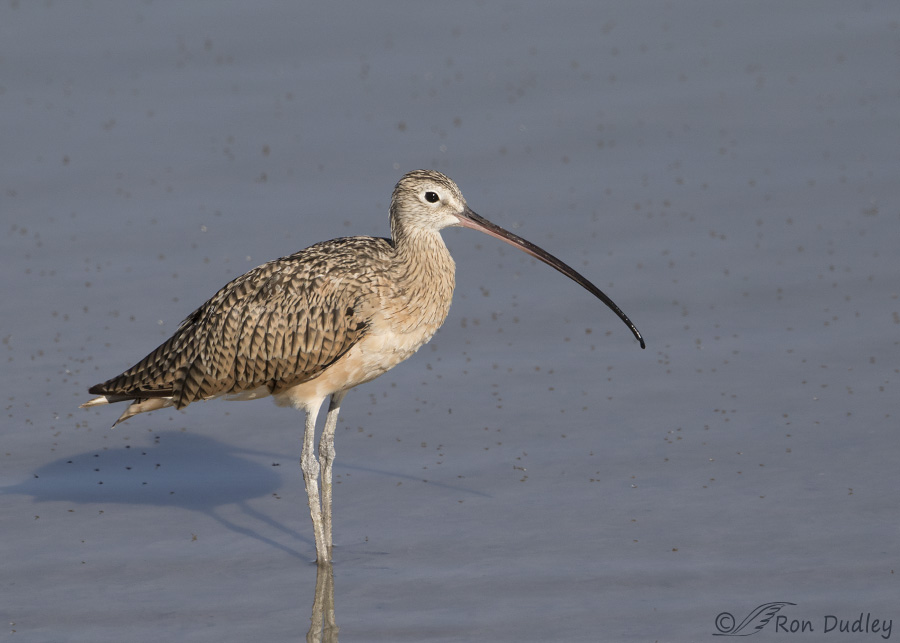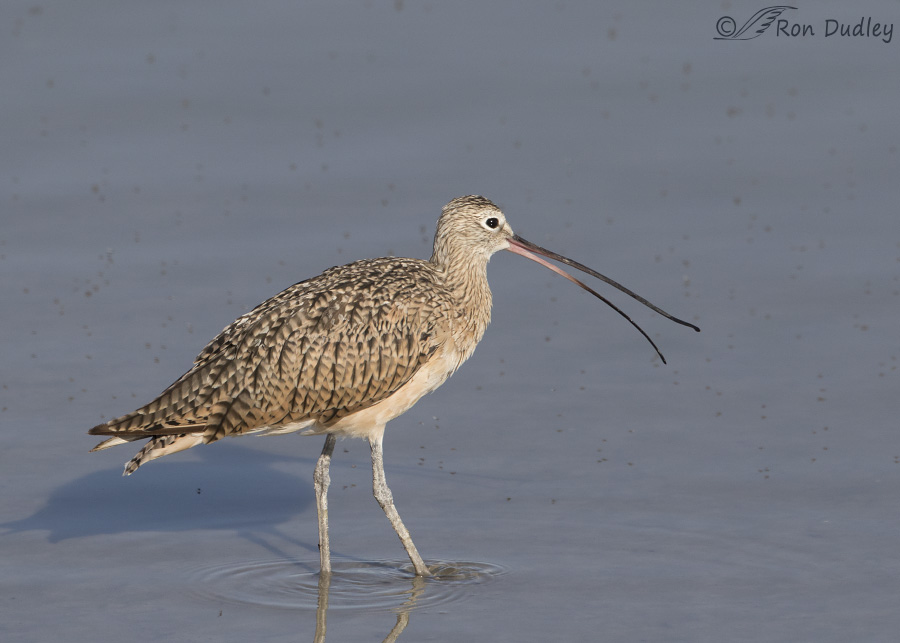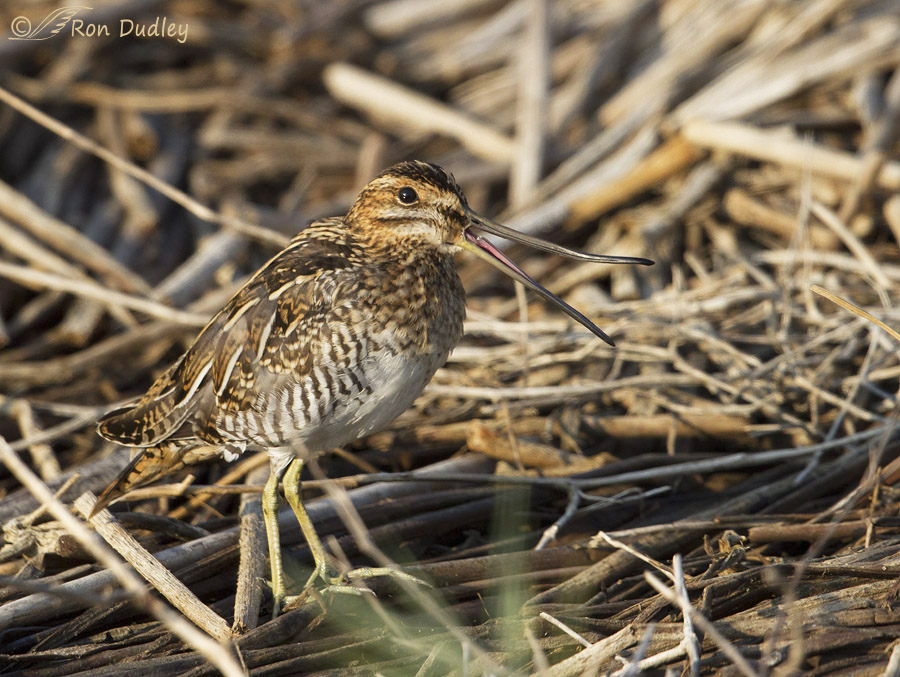Birds can do some pretty amazing things with their bills. This is one of them.

1/3200, f/6.3, ISO 400, Canon 7D Mark II, Canon EF 500mm f/4L IS II USM + 1.4 tc, not baited, set up or called in
Yesterday morning as I headed home from Antelope Island I spotted this lone Long-billed Curlew along the causeway. I didn’t have much enthusiasm for photographing it because the light was becoming harsh and it didn’t seem to be doing anything interesting but I’d been mostly skunked all morning so I trained my lens on the bird anyway.
The curlew was along the shore to feed on the plentiful brine flies that can be seen as hundreds of little dark specks on the water (no, they’re not dust bunnies…). Before we move on to the next shot notice how perfectly the upper bill (maxilla) conforms to the downwardly curved shape of the lower mandible.
Just as I was about to pull in my lens…

1/2000, f/7.1, ISO 400, Canon 7D Mark II, Canon EF 500mm f/4L IS II USM + 1.4 tc, not baited, set up or called in
the curlew opened its bill and flexed the end of its maxilla upward. The shapes of the upper and lower bill no longer conform. Sometimes the change in shape is much more extreme than this.
Many folks presume the bill of all birds to be rigid and inflexible but that’s just not the case. Many long-billed shorebirds (hummingbirds too) can flex the end of their maxilla in a process called rhynchokinesis as an aid to feeding in mud and dirt. It takes much less effort to expand only the tip of the bill while feeling for food in thick substrates than it would to expand the entire length of the bill.
Usually we don’t see it happening because the bill is buried in the mud but they sometimes do it with the bill in full view – for what reason I can only speculate.

1/3200, f/6.3, ISO 640, Canon 7D, Canon EF 500mm f/4L IS II USM + 1.4 tc, not baited, set up or called in
Last year I photographed this Wilson’s Snipe doing the same thing.
This behavior is usually done quickly and many bird photographers aren’t even aware it’s happened until they process their images at home and at that point they often believe they have a bird with a deformed bill.
I’ve posted about rhynchokinesis in the past but I thought viewers might be interested in seeing another example.
Ron


Wonderful amazing shots Ron! Thanks for sharing!
charlotte
Wow, absolutely fascinating! I had never heard of this before, and if I’ve seen it I didn’t realize it for what it was. I will definitely keep my eyes open for this in the future. Thanks!
You have to watch carefully for it, Todd. It usually happens quite fast.
Hi Ron,
I have an interesting story that made my day and I know that you will enjoy it too. Yesterday morning I was headed for town and when I went by one of the neighbors houses I saw what I thought was an injured bird. It was a harrier and it had its wing up. It was on the ground. I went back to see if it might be injured but when I got turned around and went back it had a surprise for me. It was taking a bath in the sprinkler water! It was just standing there enjoying the shower. In fact it was so busy that I don’t even think that it saw me watching. I thought of you and your camera! I took some pictures on my phone but they were not very good.
Have a great day birding! Claudia
Neat story, Claudia. Not sure I’ve ever seen a bathing harrier. Other raptors, yes but not a harrier.
Nothing quite like a good stretch in the morning, LOL.
Thanks for sharing a point I know I’ve never seen or even heard of!
You’re welcome, Alan.
Great shots as usual Ron. Wonderful captures of the bill flexibility! A perfect example of how shorebirds with long bills can deeply probe sand and grab a worm.
Thanks for sharing.
Thank you, Dick.
Thank you so much for this information Ron. I had no idea of this level of bill flexibility. Very interesting!
Thanks, Linda.
That’s just really a fun fact to know!!! Those are greats shots and…..well….who knew!!!!
I’m glad you appreciated the knowledge, Carol Thanks.
Wow, amazing. I was not aware some birds could do this. Gives you a new perspective of what is going on during feeding. I looked up the definition and also an abstract of some research done on this subject and realized the bill is considered part of the cranium. For some reason this took me by surprise thinking the bill is considered a different part of the anatomy of a bird, but it is not. Amazing even further that these birds have evolved this behavior. I guess the closest comparison in humans would be the ability to move your lips around to assist in feeding.
Thanks for the post Ron, more good stuff.
Yeah, when you do the research on the behavior it can be confusing because they use terms like “distal rhynchokinesis” and “cranial rhynchokinesis”. Thanks, Frank.
Just WOW–again! Birds just ROCK! I had no idea they could do that! There are so many really amazing adaptations for them to bend themselves to fit their environment (instead of humanity’s idea of bending the environment to fit us). I could be wrong (that’s always an option), but I think their idea is much better in terms of the getting along with the planet. Just a thought…
I don’t think you’re wrong, Laura. Just the opposite…
If you are wrong, so am I.
Badly wrong. And I don’t think so.
Teacher, I’ve finished my lesson. Can I have some more coffee now?
Help yourself, Neil. I just poured some more of my own!
Cool! 🙂 I had no idea they would do that or that some birds have some flexibility in their bills that they can control! It does make sense from a hunting perspective.
There’s always something new to learn about birds, Judy!
Hello Ron, Thanks for the “bill” information and the photos that exemplify the “flexing”–never knew! Don
You’re very welcome, Donald.
Thank you, Ron. I have taken a great number of long-billed curlew photos. I’ll have to go back through them to see if I have any doing this. I never even noticed! Thank you for the education!
Let us know if you find any, Pat.
Very interesting behavior. I don’t know that I’ve ever seen it, but am thinking I may have seen it several times this summer without realizing it because we’ve been watching Willets hunting for and eating sand crabs.
Then I’ll bet you have seen it, Susan. It usually happens quickly though…